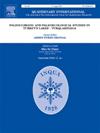Vegetation and climate patterns of western Türkiye since the late Last Glacial Period based on a new pollen record in the Aegean sea
IF 1.8
3区 地球科学
Q3 GEOGRAPHY, PHYSICAL
引用次数: 0
Abstract
A new palynological record from the uppermost 2.8 m of the 8.1 m-long core MAR03-02C (composite core) from the Aegean Sea, covering the last 20.8 ka, allows the reconstruction of palaeovegetation patterns and palaeoclimate dynamics in the surrounding landmass since the late Last Glacial Period. Variations in Mediterranean/temperate forests and herb/steppe plants indicate major climatic shifts associated with the Bølling-Allerød, Younger Dryas, and the Holocene Climatic Optimum. In the cold and dry periods, low amounts of arboreal pollen and high amounts of herbaceous and steppe pollen, including Artemisia, Cyperaceae, and Asteraceae Cichorioideae, were recorded. During the warmer periods, high AP, which was mainly characterized by deciduous Quercus, and low herbaceous/steppe plants, dominated the region surrounding the core site. However, the impacts of the Bølling-Allerød warm interval and the Younger Dryas cold episode were not strongly represented in the vegetation patterns. Warm-temperate and Mediterranean trees, mainly consisting of deciduous Quercus and Quercus ilex-type trees, reached their maximum from the onset of the Holocene at ∼11.7 to 6 ka, corresponding to the Holocene Climate Optimum and Sapropel 1 formations. Subsequently, general aridity trends and nearly modern climate patterns prevailed. The pollen record shows similarities between the previously published core MAR03-02C and regional proxy records. Anthropogenic impacts clearly occurred during the last 3.5 ka when cultivated plants became prominent in the pollen records (e.g., Olea europaea and Pistacia), with a significant decline in warm-temperate trees until 1.2 ka, suggesting that the Beyşehir Occupation Phase is also recorded in the eastern Aegean Sea.
基于爱琴海花粉新记录的末次冰期晚期以来西部基耶岛植被与气候模式
爱琴海MAR03-02C(复合岩心)长8.1 m,岩心最上层2.8 m的孢粉记录覆盖了最后20.8 ka,重建了末次冰期晚期以来周围陆块的古植被格局和古气候动态。地中海/温带森林和草本/草原植物的变化表明了与b ølling- allero ød、新仙女木期和全新世气候最佳期相关的主要气候变化。在寒冷和干燥时期,记录到的乔木花粉含量低,草本和草原花粉含量高,包括蒿科、苏柏科和菊科。在温暖期,高AP以落叶栎树为主,低AP以草本/草原植物为主。而Bølling-Allerød暖期和新仙女木期冷期的影响在植被格局中表现不明显。暖温带和地中海乔木,主要以落叶栎树和绿栎树为主,在全新世开始的~ 11.7 ~ 6 ka达到最大值,对应于全新世气候最适期和Sapropel 1组。随后,普遍的干旱趋势和接近现代的气候模式占了上风。已有的MAR03-02C岩心花粉记录与区域代用记录具有相似之处。人类活动的影响发生在最近3.5 ka,在花粉记录中,栽培植物(如油橄榄和黄松木)变得突出,直到1.2 ka,暖温带树木显著减少,表明爱琴海东部也记录了beyehir占领阶段。
本文章由计算机程序翻译,如有差异,请以英文原文为准。
求助全文
约1分钟内获得全文
求助全文
来源期刊

Quaternary International
地学-地球科学综合
CiteScore
5.60
自引率
4.50%
发文量
336
审稿时长
3 months
期刊介绍:
Quaternary International is the official journal of the International Union for Quaternary Research. The objectives are to publish a high quality scientific journal under the auspices of the premier Quaternary association that reflects the interdisciplinary nature of INQUA and records recent advances in Quaternary science that appeal to a wide audience.
This series will encompass all the full spectrum of the physical and natural sciences that are commonly employed in solving Quaternary problems. The policy is to publish peer refereed collected research papers from symposia, workshops and meetings sponsored by INQUA. In addition, other organizations may request publication of their collected works pertaining to the Quaternary.
 求助内容:
求助内容: 应助结果提醒方式:
应助结果提醒方式:


